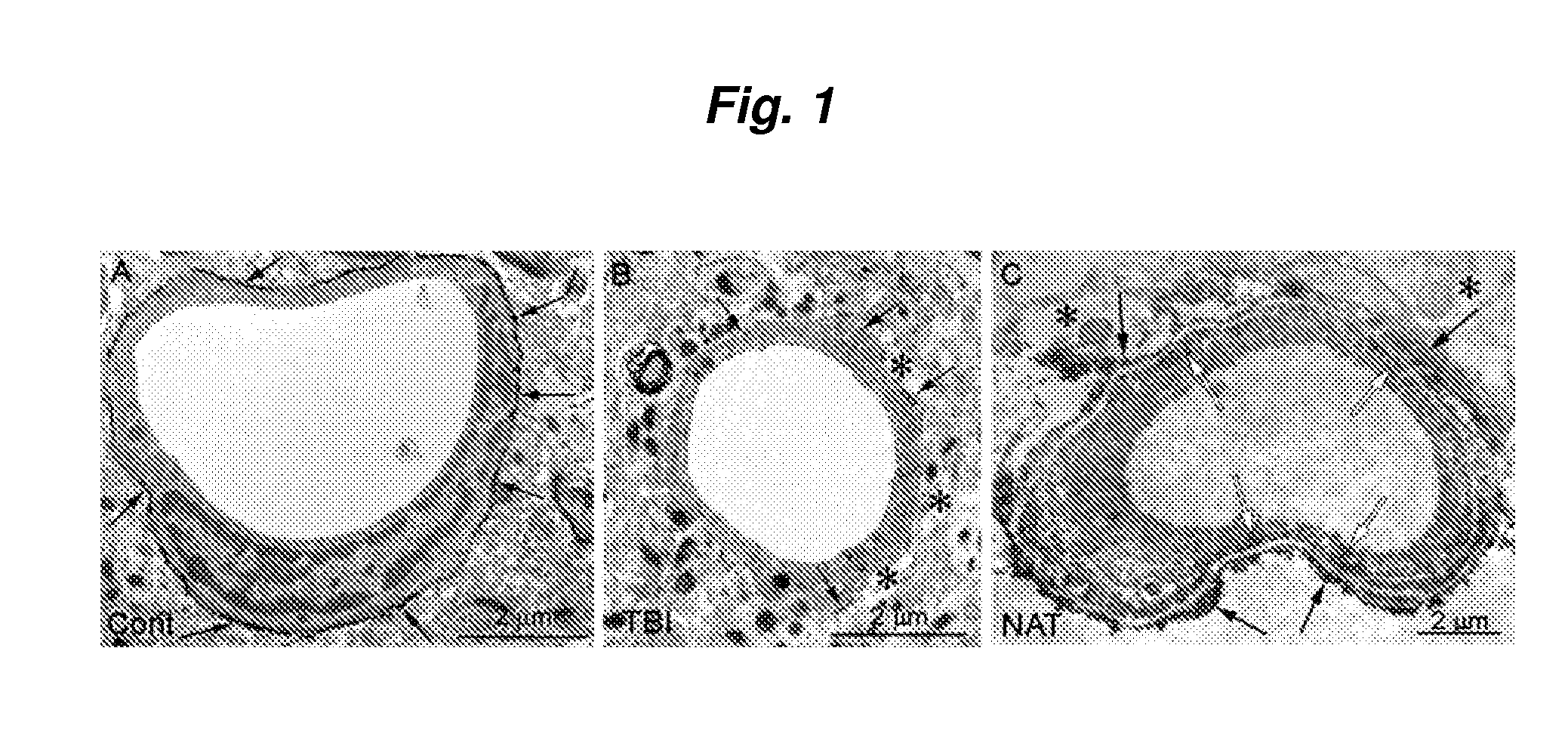Method for reducing intracranial pressure
a technology of intracranial pressure and reducing pressure, which is applied in the direction of biocide, cyclic peptide ingredients, tachykinin ingredients, etc., can solve the problems of life-threatening complications, limited ability to accommodate volume changes, and difficulty in blood perfusion and tissue oxygenation, so as to improve the prognosis and/or state of a subject.
- Summary
- Abstract
- Description
- Claims
- Application Information
AI Technical Summary
Benefits of technology
Problems solved by technology
Method used
Image
Examples
example 1
Aquaporin-4 Expression is Reduced after Traumatic Brain Injury
[0143]In terms of trying to lower intracranial pressure, osmotic diuretics, like mannitol, are routinely used, although it is recognised that their efficacy is very limited. These agents are pharmacologically inert substances that act by increasing the colloid osmotic pressure of the blood, providing a driving force for the reabsorption of water from a tissue back into the circulation. However, their ability to draw water out of the brain in a situation where there is raised intracranial pressure is questionable.
[0144]This suggested to us that, following an insult, a change must occur in the cerebral vasculature that limits the ability of water to move back out of the brain. We decided to study the water channels associated with the cerebral vasculature, and in particular aquaporin 4 (AQP-4), in order to see whether there were any changes in the expression of these channels. For these studies, a rat model was used, and ra...
example 2
Administration of N-Acetyl-L-Tryptophan after Traumatic Brain Injury Induces expression of aquaporin 4
[0149]We hypothesised that substance P may play a role in bringing about these changes in vascular function, and therefore if we were to inhibit the action of substance P, using an NK1 receptor antagonist for example, we may be able to reverse these changes.
[0150]A number of commercially synthesised substance P receptor antagonists are currently available from standard scientific chemical suppliers. We chose to use the NK1 receptor antagonist N-acetyl-L-tryptophan.
[0151]N-acetyl-tryptophan was dissolved in sterile, normal saline, and administered by intravenous injection at 30 min after induction of injury. Administration of N-acetyl-L-tryptophan after injury was found to cause a rise in the expression of aquaporin-4 to, or indeed above, pre-injury levels (FIG. 1, right-hand panel). The optimal dose, based on the ability of the drug to attenuate blood brain barrier permeability afte...
example 3
Administration of N-Acetyl Tryptophan Facilitates Movement of Water from Brain Tissue Into the Circulation in a Rat Model of Traumatic Brain Injury
[0152]The changes in aquaporin-4 expression, as well the ability of a substance P receptor antagonist to restore normal expression levels, suggested that these agents may be enable the movement of water out of the brain, which would help to reduce intracranial pressure.
[0153]In order to observe whether a substance P receptor antagonist could facilitate the movement of water out of the brain, we carried out nuclear magnetic resonance spectroscopy (NMR) studies using a rat model of traumatic brain injury. Diffusion-weighted NMR images were generated following trauma (FIG. 2, left-hand panel).
[0154]Following injury, a number of “brighter” areas are clearly visible within the brain. These “bright” areas correlate with regions where extracellular water is gathering within the brain.
[0155]Following post-injury administration of a N-acetyl-L-try...
PUM
| Property | Measurement | Unit |
|---|---|---|
| pressure | aaaaa | aaaaa |
| pressure | aaaaa | aaaaa |
| height | aaaaa | aaaaa |
Abstract
Description
Claims
Application Information
 Login to View More
Login to View More - R&D
- Intellectual Property
- Life Sciences
- Materials
- Tech Scout
- Unparalleled Data Quality
- Higher Quality Content
- 60% Fewer Hallucinations
Browse by: Latest US Patents, China's latest patents, Technical Efficacy Thesaurus, Application Domain, Technology Topic, Popular Technical Reports.
© 2025 PatSnap. All rights reserved.Legal|Privacy policy|Modern Slavery Act Transparency Statement|Sitemap|About US| Contact US: help@patsnap.com



